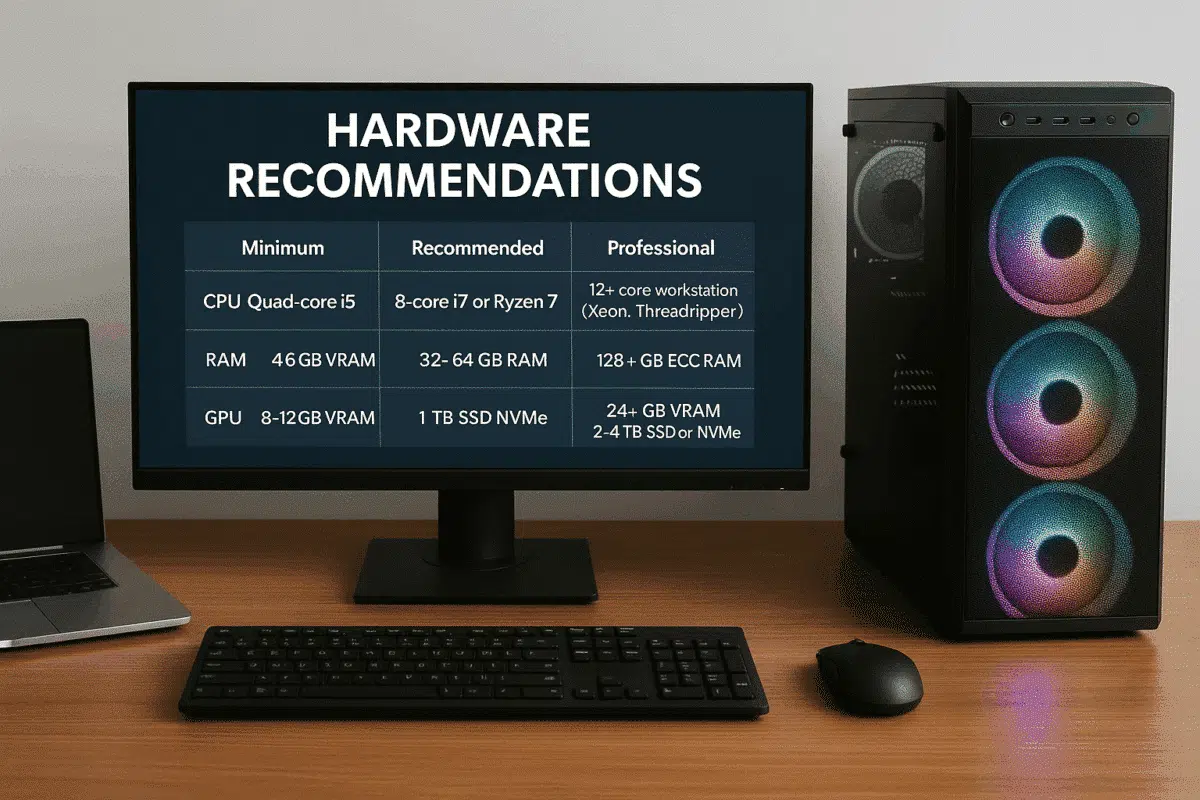Whether you’re new to photogrammetry or looking to upgrade your workstation, knowing the right hardware specifications for Agisoft Metashape is essential. RAM, CPU, GPU, and storage all play important roles in the speed, quality, and stability of 3D reconstruction workflows. In this article, we break down Metashape’s memory requirements and provide updated hardware recommendations for 2025.
Why Hardware Matters in Photogrammetry
Metashape is a computationally intensive application. Large datasets—such as drone imagery with hundreds or thousands of photos—require significant processing power. A bottleneck in RAM, CPU threads, or GPU memory can lead to long processing times or even crashes.
Minimum vs Recommended System Requirements
| Component | Minimum | Recommended | Professional |
|---|---|---|---|
| CPU | Quad-core i5 | 8-core i7 or Ryzen 7 | 12+ core workstation (Xeon, Threadripper) |
| RAM | 16 GB | 32–64 GB | 128+ GB ECC RAM |
| GPU | 4 GB VRAM (GTX 1050) | 8–12 GB VRAM (RTX 3060/3070) | 24+ GB VRAM (RTX 4090, A6000) |
| Storage | 500 GB HDD | 1 TB SSD NVMe | 2–4 TB SSD RAID or NVMe |
| OS | Windows 10 / macOS 11 | Windows 11 / macOS 13+ | Windows 11 Pro / Linux Ubuntu 22+ |
How Much RAM Does Metashape Need?
RAM is the most important component when building dense clouds, depth maps, and high-resolution meshes.
- Small projects (under 200 photos @ 12 MP): 16 GB RAM
- Medium projects (200–800 photos @ 20 MP): 32–64 GB RAM
- Large projects (1000+ photos @ 20–48 MP): 64–128 GB RAM or more
Running out of RAM will force your system to use virtual memory (pagefile), which dramatically slows performance and increases the risk of crashes.
CPU Recommendations
Metashape heavily utilizes multi-threaded processing. A modern CPU with a high number of cores and threads improves speed in:
- Photo alignment
- Depth map generation
- Dense cloud building
Recommended processors:
- Intel Core i7/i9 (12th–14th gen)
- AMD Ryzen 7/9 (5000–7000 series)
- Threadripper / Xeon (for professional setups)
GPU (Graphics Card) Recommendations
Metashape supports GPU acceleration (OpenCL and CUDA) for depth map generation and mesh building. More VRAM enables you to handle larger datasets with faster processing.
- Minimum: 4 GB VRAM (GTX 1050, AMD RX 580)
- Recommended: 8–12 GB VRAM (RTX 3060, 3070, 4060 Ti)
- Professional: 24+ GB VRAM (RTX 4090, Quadro A6000, Titan RTX)
Tip: Disable integrated GPUs (like Intel UHD) in Metashape Preferences → GPU for best stability.
Storage: SSD vs HDD
Storage affects how quickly images load and how fast Metashape writes temporary files and outputs.
- Always use SSDs—preferably NVMe drives
- 1 TB minimum recommended for medium to large projects
- Consider RAID or external fast storage for large datasets
Recommended Configurations
Entry-Level Build (Hobbyist)
- CPU: Intel i5-13400 or Ryzen 5 7600
- RAM: 32 GB DDR4
- GPU: NVIDIA RTX 3060 (12 GB)
- SSD: 1 TB NVMe
Professional Build
- CPU: Intel i9-14900K or AMD Ryzen 9 7950X
- RAM: 64–128 GB DDR5
- GPU: NVIDIA RTX 4090 or A5000 (24 GB+)
- SSD: 2 TB NVMe + 2 TB SSD secondary
Mobile Workstation (Laptop)
- CPU: Intel i7-13700H or AMD Ryzen 9 7945HX
- RAM: 32–64 GB
- GPU: NVIDIA RTX 4080/4090 Laptop GPU
- SSD: 2 TB
Operating System Compatibility
- Windows 10/11: Full CUDA & OpenCL support
- Linux Ubuntu 20.04/22.04: Stable with NVIDIA drivers
- macOS (M1/M2): CPU-only processing, no GPU acceleration
Conclusion
Choosing the right hardware for Agisoft Metashape can dramatically improve your productivity and processing speed. Focus on maximizing RAM and GPU VRAM for best performance, and always run your projects on SSD-based systems. Whether you’re a student, drone pilot, or professional 3D modeler, building the right workstation will help you get the most out of Metashape in 2025 and beyond.


